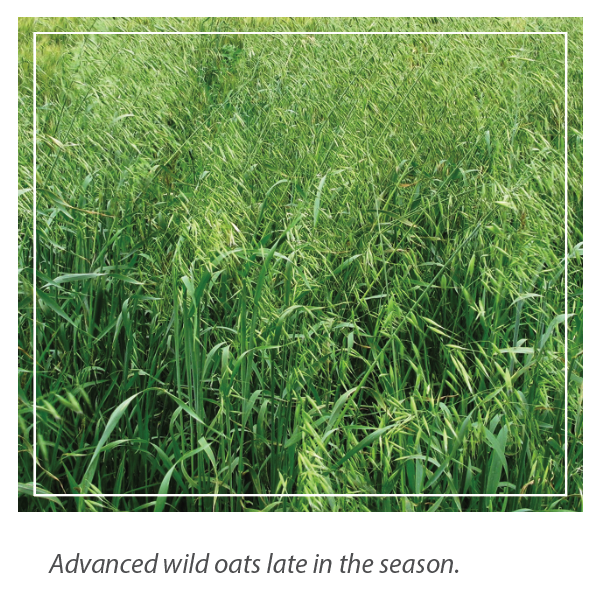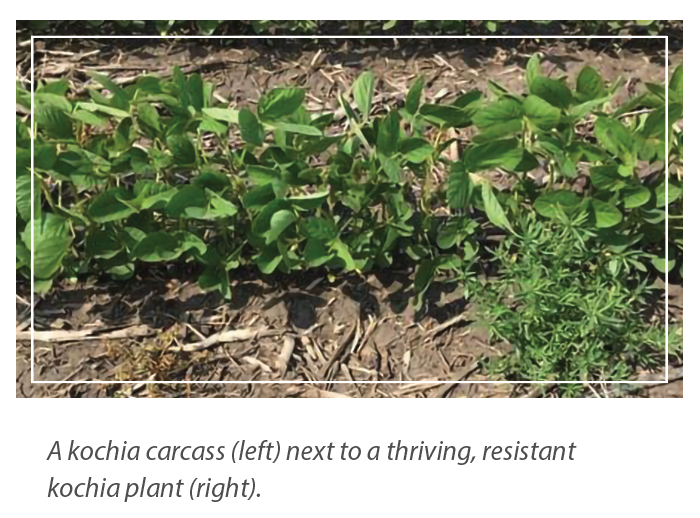Kim Brown-Livingston, Crop Specialist – Weeds, Manitoba Agriculture and Resource Development – Summer (June) 2021 Pulse Beat
 IT’S LATE SUMMER. You’ve sprayed for weeds. Between now and harvest, there’s nothing left to watch for except insects and diseases, right? Not necessarily. Your weed control program doesn’t end when the sprayer pulls out of the last field. Late season scouting for weeds is crucial for a couple of reasons. First of all, most weeds are annuals, so anything still growing after spraying is very likely setting seed this year. Knowing which weeds will be growing in that field next year helps you plan a spray program for the 2022 crop. When choosing a pre-emergent herbicide with residual weed control, you have to know what weeds are being targeted. This gets the right product on the right field to set up a good weed control program. Late-season scouting also gives us the opportunity to evaluate the effectiveness and weaknesses of this year’s weed control program. Are there weeds in the field, what are they and why are they there?
IT’S LATE SUMMER. You’ve sprayed for weeds. Between now and harvest, there’s nothing left to watch for except insects and diseases, right? Not necessarily. Your weed control program doesn’t end when the sprayer pulls out of the last field. Late season scouting for weeds is crucial for a couple of reasons. First of all, most weeds are annuals, so anything still growing after spraying is very likely setting seed this year. Knowing which weeds will be growing in that field next year helps you plan a spray program for the 2022 crop. When choosing a pre-emergent herbicide with residual weed control, you have to know what weeds are being targeted. This gets the right product on the right field to set up a good weed control program. Late-season scouting also gives us the opportunity to evaluate the effectiveness and weaknesses of this year’s weed control program. Are there weeds in the field, what are they and why are they there?
Where do we start? Aerial imagery can give you an idea of where potential problem areas could be. Drone video and photos get you a closer look, followed by a good old field walk. Scout several areas of the field. Can you compare good weed control areas to parts of the field where you can still find weeds? There can be several reasons why weeds are present after an in-crop herbicide application. It’s time to start asking questions…
- How well does your herbicide work on the weeds you’ve found? Was it labelled for control or suppression? Some products do a great job of burning off top growth, but regrowth can occur late in the season. Are those weeds on the label at all?
- Was weed pressure really high? You may have gotten good control, but you never get 100% of the weeds and under heavy pressure there could be a substantial number of weeds not controlled.
- Was there enough rainfall to activate the herbicide? This is crucial for many pre-emerge herbicides. Less than adequate precipitation with some pre-emerge products can mean poor weed control and shorter residual activity.
- How big were the weeds when you sprayed? Growth stage is critical. You have to spray when weeds are the right size — smaller is better. No matter how effective a herbicide is on a particular weed, if large weeds are sprayed past the appropriate stage, you can expect poor control or outright failure.
- And was the correct rate used? Some labels have higher rates for different weeds or larger-sized weeds. Underspraying leads to misses and poor control.
- Did you use enough water? Coverage is crucial, especially for contact herbicides. Make sure you have the proper nozzles and enough water to get the weeds covered.
- What were conditions at the time of spraying? Cool nights, hot daytime temperatures, low humidity — these conditions can reduce efficacy depending on the herbicide. If weeds were under stress for any reason, they do not take up and/or translocate the herbicide as they would under normal conditions.
- Did it rain shortly after herbicide application? Rainfast periods for pulse crop herbicides range from one hour for clethodim (Select, Centurion) and sethoxydim (Poast Ultra) to eight hours for bentazon (Basagran brands).
- Is there a pattern, such as something mechanical, like plugged nozzles, or can we see sprayer skips? Was there dust on the leaves? Dust along the roadsides or in tracks and headlands, kicked up by sprayer wheels, can affect herbicide efficacy, particularly glyphosate.
Maybe nothing went wrong at spraying. Late season weeds could be present simply because they emerged after your herbicide application. Pigweed species like waterhemp emerge all season long, and you rely on a competitive crop to reduce their impact. Healthy, vigorous crops that canopy quickly will choke out late-emerging weeds. If weeds emerged after spraying, they will be worse in areas of the field where crop growth is poor. But worst of all, late-season weeds may be present because they’re herbicide-resistant. Watch for patches of weeds, particularly where the rest of the field is quite clean. Or if you see big healthy weeds next to carcasses and other weeds of various sizes showing varying signs of herbicide damage, it’s likely a sign of herbicide resistance. All these weeds were sprayed at the same time with the same herbicide — if they’re affected differently, you should suspect herbicide resistance.
 So you’ve got late-season weeds — hopefully, you’ve figured out why they’re here. What do we do about them? Rescue treatments are limited. Bentazon may be an option depending on the weeds present and their size. Weeds present for reasons other than resistance might end up sticking around till harvest time. Remove them to reduce seed return if it is feasible. If you have late-season weeds in your fields due to gaps in your herbicide program, from errors while spraying or from less than optimal conditions when spraying, then hopefully, those issues can be fixed for next time. Make adjustments to next year’s weed control plan to reduce or eliminate these late-season weed escapes.
So you’ve got late-season weeds — hopefully, you’ve figured out why they’re here. What do we do about them? Rescue treatments are limited. Bentazon may be an option depending on the weeds present and their size. Weeds present for reasons other than resistance might end up sticking around till harvest time. Remove them to reduce seed return if it is feasible. If you have late-season weeds in your fields due to gaps in your herbicide program, from errors while spraying or from less than optimal conditions when spraying, then hopefully, those issues can be fixed for next time. Make adjustments to next year’s weed control plan to reduce or eliminate these late-season weed escapes.
However, if you suspect herbicide resistance and you don’t destroy those weeds to prevent seed return, the problem will get bigger next year. Individual plants and small patches can be hand rogued, and larger areas can be mowed. Consider not harvesting areas with resistant weeds, and instead mow several times during the season. Harvesting patches or infested areas of fields will spread resistant weed seeds over the rest of the field and combines will be contaminated with resistant weed seeds that will spread across the farm. If you choose to harvest a field with resistant weeds, do it last and clean the combine thoroughly.
Resistant weeds like kochia and wild oats on your farm can cause tremendous yield loss and increase the cost of herbicide programs. They can influence crop rotation as it becomes more and more difficult to grow crops where herbicide options are limited or options may be non-existent to tackle those weeds. Weeds like waterhemp and Palmer amaranth, whether resistant or not, are Tier 1 weeds under the Noxious Weeds Act, and as such, must be destroyed without condition. Tier 1 weeds are considered a significant threat to the agricultural community and, by law, must be destroyed. Resistance in waterhemp and Palmer amaranth develops very quickly and we cannot allow these weeds to become established here.
If you suspect herbicide resistance in any weeds, get them tested, so you know which herbicides will still work and which ones won’t. Once resistance is confirmed, sit down with your agronomists, industry advisors and company reps to develop a plan that deals with all weeds on your farm, especially the resistant ones.
